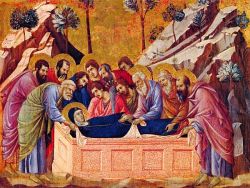A piece of earth transplanted in heaven
Warning: Invalid argument supplied for foreach() in /home/monast59/public_html/templates/yoo_moustache/styles/bose-home/layouts/article.php on line 44
by ENZO BIANCHI
We love this our earth, yet we feel constrained here; we are preoccupied about our bodies, yet feel that we are greater than our physical make-up
15 August, The passing of the B.V. Mary
Mid-August, when summer reaches its peak and begins to decline, a period of vacation in continual balance between rest and over-exposure of the body, between relaxation and bewilderment of the spirit, between opening and confusion of the mind: and in the heart of this “time for man” in his wholeness comes what is perhaps the most popular feast among those in honor of the Virgin Mary: the Assumption. Incomprehensible paradox? Contradiction of a society that by now is branded by many as secularized? Parallel worlds that criss-cross in a holiday that is common to all as far as the day goes, but not as far as the reasons for it? I think rather of a fruitful provocation. Since the earliest centuries, in fact, the Church has perceived that in Mary – the woman who in the name of all creation had received God made man and had borne Him who rose from the dead – was prefigured not only the way, but also the end that awaits everyone living: the assumption of what is human, of everything that is human into the divine. Yes, Mary is the image and corporate personality of the faithful because she is the Daughter of Zion, the holy Israel from whom was born the Messiah, and is also the Church, the Christian community that under the cross gives birth to children for the Lord. For this reason the Visionary of the Apocalypse contemplated her as the woman robed with the sun, crowned with the twelve stars of the tribes of Israel, giving birth to the Messiah (cf. Ap 12:1-2), but also as the mother of Christ’s progeny, the Church (cf. Ap 12:17). The first creature to enter “body and soul” – that is, with all of herself – into the Creator’s space and time could thus be no other than she who had given her consent that the divine might burst upon the human: vital space given by the earth to heaven, the Virgin Mother becomes the germ and first fruit of a transfigured creation. According to the belief of the Church, Mary is now beyond death and beyond judgment, in that other dimension of existence that we are unable to call anything else than “heaven.”
